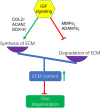IGF Signaling in Intervertebral Disc Health and Disease
- PMID: 35178405
- PMCID: PMC8843937
- DOI: 10.3389/fcell.2021.817099
IGF Signaling in Intervertebral Disc Health and Disease
Abstract
Low back pain (LBP) is a common musculoskeletal symptom, which brings a lot of pain and economic loss to patients. One of the most common causes of LBP is intervertebral disc degeneration (IVDD). However, pathogenesis is still debated, and therapeutic options are limited. Insulin-like growth factor (IGF) signaling pathways play an important role in regulating different cell processes, including proliferation, differentiation, migration, or cell death, which are critical to the homeostasis of tissues and organs. The IGF signaling is crucial in the occurrence and progression of IVDD. The activation of IGF signaling retards IVDD by increasing cell proliferation, promoting extracellular matrix (ECM) synthesis, inhibiting ECM decomposition, and preventing apoptosis and senescence of disc cells. However, abnormal activation of IGF signaling may promote the process of IVDD. IGF signaling is currently considered to have a promising treatment prospect for IVDD. An in-depth understanding of the role of IGF signaling in IVDD may help find a novel approach for IVDD treatment.
Keywords: degeneration; insulin-like growth factor; intervertebral disc; low back pain; nucleus pulposus.
Copyright © 2022 Lin, Tian, Peng, Wu, Xiao, Qing and Shao.
Conflict of interest statement
The authors declare that the research was conducted in the absence of any commercial or financial relationships that could be construed as a potential conflict of interest.
Figures



Similar articles
-
Inactivation of Tnf-α/Tnfr signaling attenuates progression of intervertebral disc degeneration in mice.JOR Spine. 2024 Oct 8;7(4):e70006. doi: 10.1002/jsp2.70006. eCollection 2024 Dec. JOR Spine. 2024. PMID: 39391171 Free PMC article.
-
The pathological mechanisms of circRNAs in mediating intervertebral disc degeneration.Noncoding RNA Res. 2023 Sep 18;8(4):633-640. doi: 10.1016/j.ncrna.2023.09.004. eCollection 2023 Dec. Noncoding RNA Res. 2023. PMID: 37780894 Free PMC article. Review.
-
Role of Caspase Family in Intervertebral Disc Degeneration and Its Therapeutic Prospects.Biomolecules. 2022 Aug 4;12(8):1074. doi: 10.3390/biom12081074. Biomolecules. 2022. PMID: 36008968 Free PMC article. Review.
-
Morroniside attenuates nucleus pulposus cell senescence to alleviate intervertebral disc degeneration via inhibiting ROS-Hippo-p53 pathway.Front Pharmacol. 2022 Sep 16;13:942435. doi: 10.3389/fphar.2022.942435. eCollection 2022. Front Pharmacol. 2022. PMID: 36188539 Free PMC article.
-
Krüppel like factor 10 prevents intervertebral disc degeneration via TGF-β signaling pathway both in vitro and in vivo.J Orthop Translat. 2021 May 15;29:19-29. doi: 10.1016/j.jot.2021.04.003. eCollection 2021 Jul. J Orthop Translat. 2021. PMID: 34094855 Free PMC article.
Cited by
-
Molecular Basic of Pharmacotherapy of Cytokine Imbalance as a Component of Intervertebral Disc Degeneration Treatment.Int J Mol Sci. 2023 Apr 22;24(9):7692. doi: 10.3390/ijms24097692. Int J Mol Sci. 2023. PMID: 37175399 Free PMC article. Review.
-
Glutamine-αKG axis affects dentin regeneration and regulates osteo/odontogenic differentiation of mesenchymal adult stem cells via IGF2 m6A modification.Stem Cell Res Ther. 2024 Dec 18;15(1):479. doi: 10.1186/s13287-024-04092-6. Stem Cell Res Ther. 2024. PMID: 39695862 Free PMC article.
-
Local application of engineered insulin-like growth factor I mRNA demonstrates regenerative therapeutic potential in vivo.Mol Ther Nucleic Acids. 2023 Oct 16;34:102055. doi: 10.1016/j.omtn.2023.102055. eCollection 2023 Dec 12. Mol Ther Nucleic Acids. 2023. PMID: 37928443 Free PMC article.
-
Macrophage-based therapy for intervertebral disc herniation: preclinical proof-of-concept.NPJ Regen Med. 2023 Jul 10;8(1):34. doi: 10.1038/s41536-023-00309-z. NPJ Regen Med. 2023. PMID: 37429889 Free PMC article.
-
Causal Relationships Between Abdominal Obesity, Type 2 Diabetes, Fasting Insulin, and Cervical Disc Disorders, Osteoporosis, and Rheumatoid Arthritis: A Mendelian Randomization Study.J Multidiscip Healthc. 2025 Aug 9;18:4933-4945. doi: 10.2147/JMDH.S529217. eCollection 2025. J Multidiscip Healthc. 2025. PMID: 40809852 Free PMC article.
References
-
- Bergknut N., Smolders L. A., Grinwis G. C. M., Hagman R., Lagerstedt A.-S., Hazewinkel H. A. W., et al. (2013). Intervertebral Disc Degeneration in the Dog. Part 1: Anatomy and Physiology of the Intervertebral Disc and Characteristics of Intervertebral Disc Degeneration. Vet. J. 195, 282–291. 10.1016/j.tvjl.2012.10.024 - DOI - PubMed
Publication types
LinkOut - more resources
Full Text Sources
Other Literature Sources
Miscellaneous

